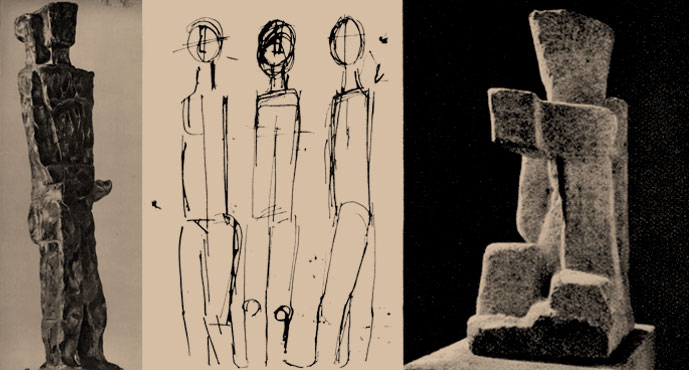
Fritz Wotruba, Standing figure; Studio (drawing); Composition
The works of the Austrian sculptor Fritz Wotruba will certainly have attracted the attention of visitors at the latest Biennale in Venice.
In the bright Austrian pavilion designed by Hoffmann and situated amidst a selected and representative artistic display, Wotruba’s big stones or small bronzes – the sculptor had already exhibited there in 1948, 1950, 1952 – stand out from the rest of the works, be they paintings, drawings or sculptures. Now, an excellent book on Wotruba has been printed, so we can better understand his work. It also makes a valid contribution to his bibliography, both for the great care given to the volume by Brüder Rosenbaum, and the exhaustive essay written by Elias Canetti. The book has been published in response to the travelling exhibition of Wotruba’s works, which was organised by the Institute of Modern Art, Boston, last April and then moved to several American cities.
Wotruba, as well as being included several times at the Venice Biennale – he first took part in it in 1932, when he was only twenty-five – has had repeated contacts with Italian artists and Italian art. I remember an exhibition organised by Ettore Gian Ferrari, a man gifted with great intuition, in his art gallery in Milan, in 1952. The exhibition did not receive great critical acclaim, but even today I can still recall some wonderful drawings and some small well-made bronze sculptures from that show. Wotruba’s work was also included in the “Mostra Internazionale del Disegno” (International Drawing Exhibition) organised in Bergamo in 1950, a show which unfortunately has never been repeated. His work has also been seen in an open-air sculpture exhibition at Villa Mirabello, Varese in 1953, as well as in Rome in 1947 and 1955, during a sculpture show organised by the Austrian Cultural Centre. I would particularly like to mention the exhibition at the Kunsthalle in Basel in 1943, where Wotruba showed his works alongside those by Marino Marini, Germaine Richier and Arnold D’Altri, as well as the exhibition in Salzburg in 1952 which included works by Marino Marini and Henry Moore. I mention the contacts Wotruba had with Italy because I think it can throw some light on the interpretation of his works, and also because I am under the impression, even if these are the first few pages that an art magazine dedicates to his work, that I am talking about works of art which are not totally unknown in Italy, or at least about an artist whose name is not totally unfamiliar here.
Wotruba was born in Vienna in 1907, one of the most thriving cultural centres at the beginning of the 20th Century. He therefore had the opportunity to absorb the international cultural atmosphere around him. During the last war, he had the chance to study in Switzerland, which at that terrible time, when Europe was at war, was an oasis of peace where artists had great freedom, and the art world in Switzerland was consequently thriving. He lived as a refugee in Zug from 1938 to 1946, after which he went back to Vienna to take up the invitation to teach sculpture at the Art Academy. To my mind, the monograph on Wotruba by Elias Canetti is not exhaustive about the first period of Wotruba’s work, and the book by J.R. De Salis published by Graphis – Zurich, 1948 – offers further information. However, in the text by Canetti, the more recent output of Wotruba is well documented. I personally believe that this is the most important part of his work, the part that enables us to understand Wotruba’s personality with better and more lucid logic. His personality is certainly rather unique and has allowed him to be placed, within few years, among the most important sculptors in Europe and indeed in the world. His way of expressing his art is so personal, so different from the various “isms” of the time. I have come to believe that thanks to such unique qualities he could become – at least in Austria – the founder of a style, of a new group of sculptors. This is also supported by the spontaneous creation of a new generation of young Austrian sculptors, who cite him as an influence.
Wotruba uses stone worked with direct cutting, almost always using the tip of his tools, and therefore showing his great knowledge of both the tools and the material. His bronzes are equally modelled with great expertise and with superb results that can only be achieved by means of imagining the final sculpture before it was actually made, thanks to his deep knowledge of the use of bronze. The poetic world of Wotruba pivots around the human figure and never loses touch with it. It is a recurrent and rigorous theme capable of bearing all the potential problems of sculpture, while refusing any hedonistic attraction, established assumptions or purely formal propositions. Seated figures, bent over in silence, identify with inner pain, arms folded over the chest as if to stop a movement, a gesture which otherwise would make them seem to rave and to act improperly. The faces express a meditative state rather than a lost expression. There is such internal strength in Wotruba’s sculptures as to make one think that the force tightens the stone within itself, preventing the sculptures from expanding, from losing themselves in the friction of gestures not familiar to them, which would therefore be totally alien and not right for the painful vision Wotruba has of man and his feelings. I am talking about those stones, about those exhausted female figures which are seated, squatting, curled up or reclining with a sort of ancient adherence to the earth, from which they seem to get their energy, just as trees do. Figures that seem to contemplate a world that is human only due to the sorrow mirrored in it, mystical forms that grant the air surrounding them a mysterious, metaphysical silence. Standing men and women, like erect human cathedrals, full of strength against something that is unfamiliar both to them and to us. Immobility to them is a static condition, in spite of their attempt to make a gesture or to take a step. Their bodies stand straight, perpendicular to the ground like monolithic stones with anthropomorphic shapes. And as in the bronze or stone high reliefs, more than one figure is present, still silent and solemn like people gathering on the stage of an imaginary play, the rhythm shaping them together is nevertheless a vertical one – as it was for the Byzantine and Gothic styles.
The light which is stopped by the angular and precise profiles is the clear scaffolding that holds up these sculptures, along with its opposite: the shadow.
Deep and dark cuts like wounds, deep shadows, gashes and surfaces on which light dazzles find a balance in their common function, even though their contrasting origins seem to collide with each other. Here is where we find the great constituent lesson of Wotruba, as well as in his superb balancing of volumes, and in the rhythm that is there within those volumes. They are paced in a musical way, with a heavy, deep tone. In Wotruba’s figures we can identify a sort of “gigantism” as if they were rocks that have tumbled down into a valley from the mountaintop, contemplating the vast silence of the valley while seeming to be precariously placed.
Of whom might Wotruba remind us? Whose art is he close to? To my mind, he has the same value as artists like Sironi or Permeke.
The vibrant animation of the surfaces, the way they interact with light; the enclosed lyrical vitality; the well-defined framing, never the result of a casual act; an essential constructivist sense of a sculptor-architect; strength and inventive capability; the aggressiveness that overwhelms the artist in his act of creation; the noble aspect that he manages to confer upon stone, which makes it eternal and immutable; the extreme limit to which the essential is taken; the formal coherence, the severity, the discipline, the rigour, the total lack of whatever form of vague intellectualism: these are the best and undeniable merits of Wotruba. We cannot deny him all these aspects, not because of a possible enthusiastic reaction to his work, but as an objective consideration of it. It is not by chance that the first and most important review of Wotruba’s work was written by a true master of modern sculpture: Aristide Maillol. In 1929, Maillol went to an Austrian art exhibition at the Jeu de Paume, where he saw a large stone torso and could not believe that such magnificent work had been made by a twenty-two-year-old. From that moment until his tragic death, Maillol never stopped being interested and following the development of the young Viennese artist’s work. He had the correct perception, and Wotruba’s works simply confirm it, bearing out the trust the wise elder had put in the young artist. These very acts are the signposts of the development of art, which give it a sense of continuity only time can judge.

